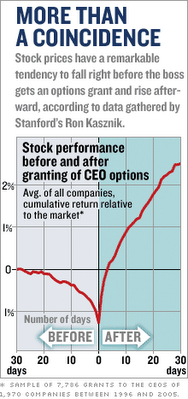Dealing with Iran
Jules Crittenden has an interesting take on what should be done about Iran:
Another aspect of the Iran "question" which I think generally goes unnoticed in the West, is the regime's increasing fragility. This is underlined in another essay in Commentary's November issue by Amir Taheri, Getting Serious About Iran: For Regime Change (will also require subs. after the end of the month; a free version can be found here or here):
An erroneous assumption has been made by the Iranians and by many in the west that because our ground forces are hyper-extended in Iraq, and Iranian nuke facilities are buried deep, there is nothing the United States can do about an Iranian nuclear program. This is not true. There is no need to invade or occupy Iran. We do not want to do that. We would prefer to see the Iranian people's desire for free elections honored, but that doesn't appear likely any time soon.Do read the whole thing. Interestingly it mirrors a more detailed - and very interesting - analysis in this month's Commentary by Arthur Herman, entitled Getting Serious About Iran: A Military Option (will require subs. after the end of the month; a free version can be found here).
What we have to do to influence Iran is explain that if Iran does not begin to cooperate with the international community, we will substantially isolate Iran and destroy its means of supporting terrorism and pursuing nuclear weapons. This can be done incrementally, to give the Iranians an opportunity to reconsider their policy. Our Navy, not hyper-extended in Iraq, can blockade their ports. Our Air Force, also not hyper-extended in Iraq, can begin reducing their terrorist-support infrastructure. Things like oil fields, refineries and roads leading toward Syria and suspected nuclear sites. This can continue ... pretty much as long as the Iranians want it too.
Another aspect of the Iran "question" which I think generally goes unnoticed in the West, is the regime's increasing fragility. This is underlined in another essay in Commentary's November issue by Amir Taheri, Getting Serious About Iran: For Regime Change (will also require subs. after the end of the month; a free version can be found here or here):
There remains another option: regime change. The very mention of this term drives some people up the wall, inspiring images of an American invasion, a native insurgency, suicide bombers, and worse. But military intervention and pre-emptive war are not the only means of achieving regime change.Do read the whole thing.
What matters is to be intellectually clear about the issue at hand. The U.S. will not be safe as long as Iran, a key country in a region of vital importance to the world economy and to international stability, remains the embodiment of the Khomeinist cause. Nor can the U.S. allow the Khomeinist movement, itself a version of global Islamism, to achieve further political or diplomatic gains at the expense of the Western democracies.
For consider the consequences if that were to happen. The most immediate would be to strengthen the mullahs and demoralize all those inside Iran who have a different vision of their country’s future and an active desire to bring it about. In 1937 and 1938, many professional army officers in Germany, realizing that Hitler was leading their nation to disaster, had begun to discuss possible ways of getting rid of him. But the Munich “peace” accords negotiated by British Prime Minister Neville Chamberlain handed Hitler a diplomatic triumph and, with it, a degree of international legitimacy that, from then on, any would-be putschists could hardly ignore.
In the Middle East, this story has been repeated many times. The West helped Gamal Abdel Nasser transform the Suez fiasco into a political triumph, thereby encouraging an even bigger and, for Egypt, more disastrous, war in 1967. The 1991 ceasefire that allowed Saddam Hussein to remain in power in Baghdad, interpreted by him as a signal of American weakness, emboldened him quickly to eliminate his domestic opponents and to begin preparations for a bigger war against the “infidel.” After the first al-Qaeda attack on New York’s World Trade Center in 1993, President Clinton dispatched a string of envoys to Afghanistan to strike a bargain with Mullah Muhammad Omar and the Taliban. Not only, to quote the Taliban foreign minister, was this seen as "a sign of weakness by the Crusader-Zionists," and one that immensely enhanced the prestige of al Qaeda and Osama bin Laden, but it discouraged the anti-Taliban forces, many of whom concluded there was no point in fighting a foe backed by the world’s only superpower.
[...]
But—some might object—even granting the virtue of the idea, how realistic is regime change in Iran? Can it happen?
The short answer is yes. Without underestimating the power still held by the mullahs over the Iranian people, let alone their ability to wreak devastating havoc in places near and far, a number of factors suggest that, like other revolutionary regimes before them, their condition is more fragile than may at first appear.
One sign is the loss of regime legitimacy. The Islamic Republic owed its initial legitimacy to the revolution of 1979. Since then, successive Khomei-nist administrations have systematically dismantled the vast, multiform coalition that made the revolution possible. The Khomeinists have massacred their former leftist allies, driven their nationalist partners into exile, and purged even many Islamists from positions of power, leaving their own base fractured and attenuated.
The regime's early legitimacy also derived from referendums and elections held regularly since 1979. In the past two decades, however, each new election has been more "arranged" than the last, while the authoritarian habit of approving candidates in advance has become a routine part of the exercise. Many Iranians saw last year's presidential election, in which Ahmadinejad was declared a surprise winner, as the last straw: credited with just 12 percent of the electorate’s vote in the first round, he ended up being named the winner in the second round with an incredible 60 percent of the vote.
Still another source of the regime's legitimacy was its message of "social justice" and its promise to improve the life of the poor. This, too, has been subverted by reality. Today, more than 40 percent of Iran's 70 million people live below the poverty line, compared with 27 percent before the Khomeinists seized power. In 1977, Iran’s GDP per head per annum was the same as Spain's. Today, Spain's GDP is four times higher than Iran's in real dollar terms. As the gap between rich and poor has widened to an unprecedented degree, the corruption of the ruling mullahs, and their ostentatious way of life, have made a mockery of slogans like "Islamic solidarity."
A second sign is the presence of a major split within the ruling establishment itself. The list of former Khomeinists who have distanced themselves from today’s regime reads like a who's who of the original revolutionary elite. It includes former "student" leaders who raided the U.S. embassy in 1979, former commanders of the Islamic Revolutionary Guard Corps, and dozens of former cabinet ministers and members of the Islamic Majlis (parliament). Most have adopted a passive stance vis-à-vis the regime, but a surprising number have clearly switched sides, becoming active dissidents and thereby risking imprisonment, exile, or even death. Any decline in the regime’s international stature could deepen this split within the establishment, helping to isolate the most hardline Khomeinists.
A third harbinger is that the regime's coercive forces have become increasingly reluctant to defend it against the people. Since 2002, the regular army, the Islamic Revolutionary Guard Corps, and the professional police have refused to crush workers’ strikes, student demonstrations, and other manifestations of anti-regime protest. In many instances, the mullahs have been forced to deploy other, often unofficial, means, including the so-called Ansar Hizballah ("Supporters of the Party of God") and the Baseej Mustadafeen ("Mobilization of the Dispossessed").
A fourth sign is the emergence of alternative sources of moral authority in Iranian society. Even in religious matters, more and more Iranians look for guidance to non-official or even anti-official mullahs, including the clergy in Iraq. (Admittedly, this is partly due to the fact that the present "Supreme Guide," Ali Khamenei, is a mid-ranking mullah who would never be accepted by senior Shiite clergy as a first among equals.)
As for non-religious matters, there was a time when the regime enjoyed the support of the overwhelming majority of Iran's "creators of culture." Today, not a single prominent Iranian poet, writer, filmmaker, composer, or artist endorses the Khomei- nists; most have become dissidents whose work is either censored or banned. Opposition intellectuals, clerics, trade-union leaders, feminists, and students are emerging as new sources of moral authority.
Finally, there are at least the outlines, although no more than the outlines, of a political alternative. Like nature, society abhors a vacuum. In the case of Iran, that vacuum cannot be filled by the dozen or so groups in exile, although each could have a role in shaping a broad national alternative. What is still needed is an internal political opposition that can act as the nucleus of a future government.

